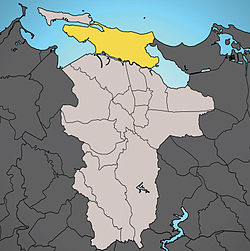
Back سانتورس AZB Santurce (San Juan) Catalan Santurce Barrio CEB Santurce (Puerto Rico) Spanish Santurce (Puerto Rico) Basque سانتورس Persian Santurce (Porto Rico) French Santurce, San Xoán Galician Santurce (Porto Rico) Italian
Santurce | |
|---|---|
 Aerial view of Santurce in 2008 | |
 Location of Santurce shown in yellow within San Juan shown in light gray | |
| Commonwealth | Puerto Rico |
| Municipality | San Juan |
| Area | |
• Total | 8.70 sq mi (22.53 km2) |
| • Land | 5.24 sq mi (13.57 km2) |
| • Water | 3.46 sq mi (8.96 km2) |
| Elevation | 49 ft (15 m) |
| Population | |
• Total | 69,469 |
| • Density | 13,257.4/sq mi (5,118.7/km2) |
| (US Census 2020) | |
| Time zone | UTC−4 (AST) |
| ZIP Codes | 00907, 00908, 00909, 00911, 00912, 00913, 00914, 00915, 00916, 00936, 00940 |
Santurce (Spanish pronunciation: [sanˈtuɾse], meaning Saint George from Basque Santurtzi) is the largest and most populated barrio of the municipality of San Juan, the capital city of Puerto Rico. With a population of 69,469 in 2020, Santurce is also one of the most densely populated areas of the main island of Puerto Rico (13,257.4 persons per square mile (5,178.6/km2)) with a population larger than most municipalities of the territory.[2]
Founded as San Mateo de Cangrejos in the 1760,[3] Santurce officially became part of the municipality of San Juan in 1863.[4] From its original settlement, its history has been marked by diverse waves of immigration, particularly of Afro-Puerto Rican, Chinese, Jewish and Dominican communities who have left a cultural imprint in the area.[5][6][7][8] In the 20th century, it grew as a key economic and cultural center of San Juan with an influx of businesses, theaters, and hotels, making it one of the most significant cultural districts in Puerto Rico.[9][10][11][12] Today, Santurce's neighborhoods like Condado and Miramar have become popular tourist and commercial areas.[13]
- ^ U.S. Geological Survey Geographic Names Information System: Santurce Barrio
- ^ "Link to Puerto Rico – San Juan". Proyecto Salón Hogar (in Spanish). Retrieved November 29, 2012.
- ^ "Parroquia San Mateo/ Santurce – Arquitectura Histórica de Puerto Rico" (in Spanish). December 5, 2013. Retrieved October 10, 2020.
- ^ "Encyclopedia of Puerto Rico" (in English and Spanish). San Juan: Fundación Puertorriqueña de las Humanidades. OCLC 234072526. Retrieved May 24, 2017.
- ^ Martinez, Robert A. "African Aspects of the Puerto Rican Personality". ipoaa.com. Archived from the original on December 14, 2007. Retrieved March 22, 2016.
- ^ "SELECTED POPULATION PROFILE IN PUERTO RICO 2009-2011 American Community Survey 3-Year Estimates". Data Set: 2010 U.S. Census. U.S. Census Bureau. Archived from the original on February 12, 2020. Retrieved November 9, 2011.
- ^ Society For Crypto Judaic Studies, Harry Ezratty, Profile Archived April 30, 2008, at the Wayback Machine, cryptojews.com; accessed March 18, 2015.
- ^ "San Juan: Culture & Community". Reform Judaism. Retrieved December 6, 2022.
- ^ Teleview Productions (Emerson Yorke Studios). "Report on Puerto Rico, U.S.A. (1955)". Prelinger Archives. Retrieved July 13, 2010.
- ^ Bliss, Peggy Ann. "A walking tour of Santurce (Part II)". Puerto Rico Daily Sun. Retrieved April 5, 2010.
- ^ Adoquín, Periódico El (December 21, 2021). "Santurce: Un barrio levantado por el arte". Periódico El Adoquín (in Spanish). Retrieved October 25, 2024.
- ^ Diálogo, Por Especial para (October 31, 2015). "Santurce suena a diversidad". Diálogo UPR (in Spanish). Retrieved October 25, 2024.
- ^ "Exploring the Santurce Neighborhood". Discover Puerto Rico. Retrieved October 25, 2024.